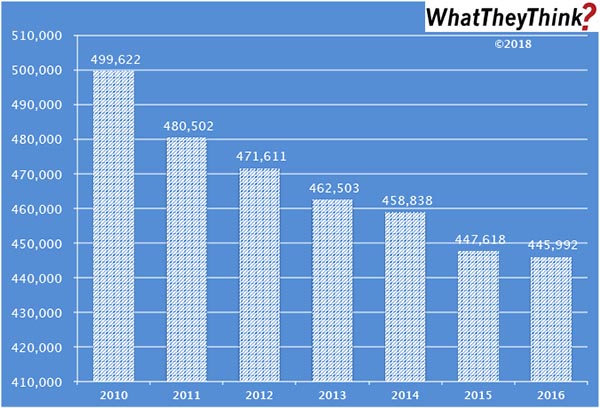
In 2010, there were a total of 499,622 employees in all commercial printing and related support businesses (NAICS 323). By 2016 (the most recent year for which we have data), overall industry employment had declined -10.7% to 445,992. (Establishments in NAICS 323 dropped -12.4% in this same period.) The decline in industry employment is not mainly a case of displaced workers being out on the street thanks to closures or consolidation; in fact, ask any print business owner and they’ll tell you that finding employees is among their biggest challenges. Rather, a lot of these declines are largely due to retirement and workers otherwise exiting the industry without a ready pool of next-generation employees waiting to be hired.
It’s also interesting that the automation trend runs in an opposite direction in our industry than in other industries. Usually, automation displaces current employees, such as in industrial manufacturing businesses. In the printing industry, automation is increasingly being looked to as a solution to employees who have already been self-displaced.
Throughout 2018, we have been highlighting data from our Commercial Printing Establishments, which complements and supplements our regular tracking of printing industry shipments and other industry data. These counts are based on data from the Census Bureau’s County Business Patterns, but County Business Patterns includes other data, as well, such as number of employees. As you recall from our establishments data over the past months, these counts are broken down by commercial printing business classification (based on NAICS, the North American Industrial Classification System):
- 323 (Printing and Related Support Activities)
- 32311 (Printing)
- 323111 (Commercial Printing, except Screen and Books)
- 323113 (Commercial Screen Printing)
- 323117 (Books Printing)
- 32312 (Support Activities for Printing—aka prepress and postpress services)
These data, and the overarching year-to-year trends, like other demographic data, can be used not only for business planning and forecasting, but also sales and marketing resource allocation.
Every other week, as we head into 2019, in addition to establishments, we will be breaking these employment and other CBP data down in different ways.









